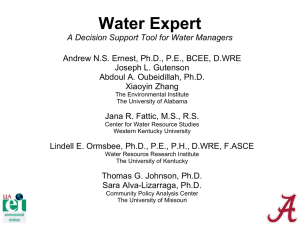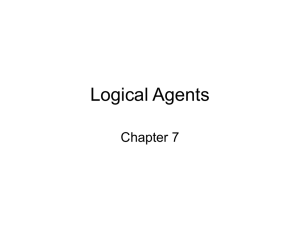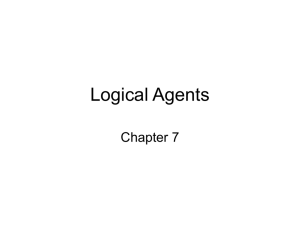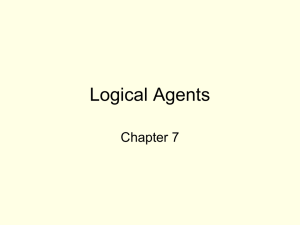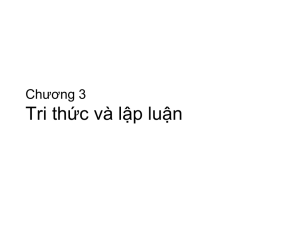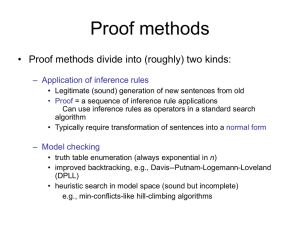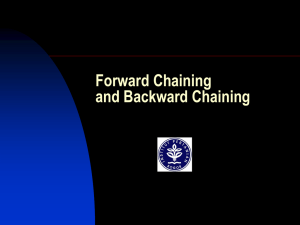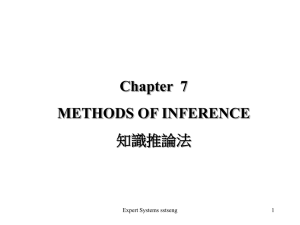Ch7-Logical Agents
advertisement
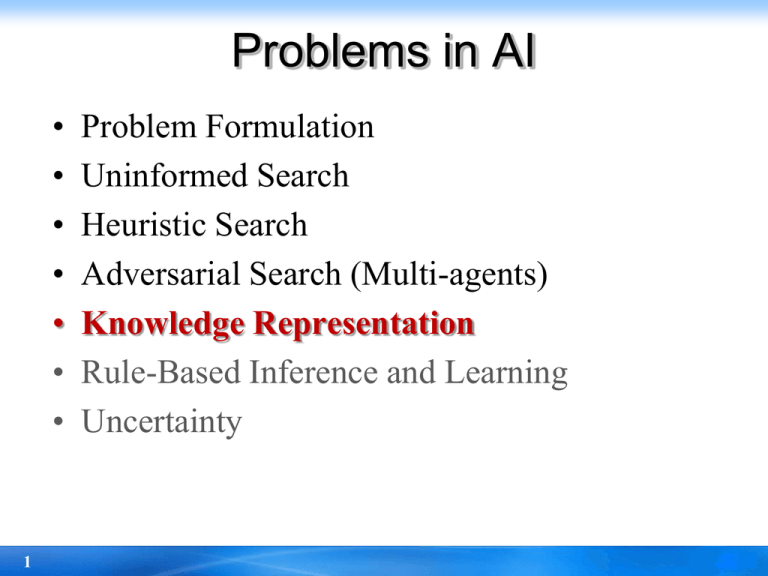
Problems in AI
•
•
•
•
•
•
•
1
Problem Formulation
Uninformed Search
Heuristic Search
Adversarial Search (Multi-agents)
Knowledge Representation
Rule-Based Inference and Learning
Uncertainty
Logical Agents
Chapter 7
2
Outline
•
•
•
•
•
•
Knowledge-based agents
Wumpus world
Logic in general - models and entailment
Propositional (Boolean) logic
Equivalence, validity, satisfiability
Inference rules and theorem proving
– forward chaining
– backward chaining
– resolution
3
Knowledge bases
Inference Engine
Domain-independent Algorithm
Knowledge Base
Domain-Specific Content
• Knowledge base = set of sentences in a formal language
• Declarative approach to building an agent (or other system):
– Tell it what it needs to know
• Then it can Ask itself what to do - answers should follow from
the KB
• Agents can be viewed at the knowledge level
i.e., what they know, regardless of how implemented
• Or at the implementation level
– i.e., data structures in KB and algorithms that manipulate them
4
Propositional Logic:
A Very Simple Logic
5
A simple knowledge-based agent
• The agent must be able to:
– Represent states, actions, etc.
– Incorporate new percepts
– Update internal representations of the world
– Deduce hidden properties of the world
– Deduce appropriate actions
6
Wumpus World PEAS description
• Performance measure
– gold +1000, death -1000
– -1 per step, -10 for using the arrow
• Environment
–
–
–
–
–
–
–
Squares adjacent to wumpus are smelly
Squares adjacent to pit are breezy
Glitter iff gold is in the same square
Shooting kills wumpus if you are facing it
Shooting uses up the only arrow
Grabbing picks up gold if in same square
Releasing drops the gold in same square
• Sensors: Stench, Breeze, Glitter, Bump, Scream
• Actuators: Left turn, Right turn, Forward, Grab, Release, Shoot
7
Wumpus world characterization
•
•
•
•
•
•
8
Fully Observable No – only local perception
Deterministic Yes – outcomes exactly specified
Episodic No – sequential at the level of actions
Static Yes – Wumpus and Pits do not move
Discrete Yes
Single-agent? Yes – Wumpus is essentially a natural
feature
Exploring a wumpus world
9
Exploring a wumpus world
10
Exploring a wumpus world
11
Exploring a Wumpus World
12
Exploring a wumpus world
13
Exploring a wumpus world
14
Exploring a wumpus world
15
Exploring a wumpus world
16
Logic in general
• Logics are formal languages for representing
information such that conclusions can be drawn
• Syntax defines the sentences in the language
• Semantics define the "meaning" of sentences;
– i.e., define truth of a sentence in a world
• E.g., the language of arithmetic
– x+2 ≥ y is a sentence; x2+y > {} is not a sentence
– x+2 ≥ y is true iff the number x+2 is no less than the number y
– x+2 ≥ y is true in a world where x = 7, y = 1
– x+2 ≥ y is false in a world where x = 0, y = 6
17
Entailment
• Entailment means that one thing follows from another:
KB ╞ α
• Knowledge base KB entails sentence α if and only if α
is true in all worlds where KB is true
– E.g., the KB containing “the Giants won” and “the Reds won”
entails “Either the Giants won or the Reds won”
– E.g., x+y = 4 entails 4 = x+y
– Entailment is a relationship between sentences (i.e., syntax)
that is based on semantics
18
Models
• Logicians typically think in terms of models, which are formally
structured worlds with respect to which truth can be evaluated
• We say m is a model of a sentence α if α is true in m
• M(α) is the set of all models of α
• Then KB ╞ α iff M(KB) M(α)
– E.g. KB = Giants won and Reds
won; α = Giants won
19
Entailment in the wumpus world
• Situation after detecting
nothing in [1,1], moving right,
breeze in [2,1]
• Consider possible models for
KB assuming only pits
• Boolean choices 8 possible
models
20
Wumpus models
21
Wumpus models
• KB = wumpus-world rules + observations
22
Wumpus models
• KB = wumpus-world rules + observations
• α1 = "[1,2] is safe", KB ╞ α1, proved by model checking
23
Wumpus models
• KB = wumpus-world rules + observations
24
Wumpus models
• KB = wumpus-world rules + observations
• α2 = "[2,2] is safe", KB ╞ α2
•
25
Property of inference algorithm
• An inference algorithm that derives only entailed sentences is called sound
or truth-preserving.
• An inference algorithm is complete if it can derive any sentence that is
entailed.
• if KB is true in the real world, then any sentence Alpha derived from KB by
a sound inference procedure is also true in the real world.
• The final issue that must be addressed by an account of logical agents is that
of grounding-the connection, if any, between logical reasoning processes
and the real environment in which the agent exists.
• Sensors and learning
26
Propositional logic: Syntax
• Propositional logic is the simplest logic – illustrates basic
ideas
• The proposition symbols P1, P2 etc are sentences
–
–
–
–
–
If S is a sentence, S is a sentence (negation)
If S1 and S2 are sentences, S1 S2 is a sentence (conjunction)
If S1 and S2 are sentences, S1 S2 is a sentence (disjunction)
If S1 and S2 are sentences, S1 S2 is a sentence (implication)
If S1 and S2 are sentences, S1 S2 is a sentence (biconditional)
from highest to lowest
27
Propositional logic: Semantics
28
Propositional logic: Semantics
Each model specifies true/false for each proposition symbol
E.g. P1,2
P2,2
P3,1
false
true
false
With these symbols, 8 possible models, can be enumerated automatically.
Rules for evaluating truth with respect to a model m:
S
is true
S1 S2 is true
S1 S2 is true
S1 S2 is true
i.e., is false
S1 S2 is true
iff
iff
iff
iff
iff
iff
S is false
S1 is true
S1is true
S1 is false
S1 is true
S1S2 is true
and
or
or
and
and
S2 is true
S2 is true
S2 is true
S2 is false
S2S1 is true
Simple recursive process evaluates an arbitrary sentence, e.g.,
P1,2 (P2,2 P3,1) = true (true false) = true true = true
29
Truth tables for connectives
30
Wumpus world sentences
Let Pi,j be true if there is a pit in [i, j].
Let Bi,j be true if there is a breeze in [i, j].
P1,1
B1,1
B2,1
• "Pits cause breezes in adjacent squares“
B1,1
B2,1
31
(P1,2 P2,1)
(P1,1 P2,2 P3,1)
Truth tables for inference
32
Inference by enumeration
• Depth-first enumeration of all models is sound and complete
•
• For n symbols, time complexity is O(2n), space complexity is
O(n)
33
Logical equivalence
• Two sentences are logically equivalent} iff true in same models:
α ≡ ß iff α╞ β and β╞ α
34
Validity and satisfiability
A sentence is valid if it is true in all models,
e.g., True,
A A, A A, (A (A B)) B
Validity is connected to inference via the Deduction Theorem:
KB ╞ α if and only if (KB α) is valid
A sentence is satisfiable if it is true in some model
e.g., A B,
C
A sentence is unsatisfiable if it is true in no models
e.g., AA
Satisfiability is connected to inference via the following:
KB ╞ α if and only if (KB α) is unsatisfiable
α╞ β if and only if the sentence (α ¬β ) is unsatisfiable
35
Proof methods
• Proof methods divide into (roughly) two kinds:
– Application of inference rules
• Legitimate (sound) generation of new sentences from old
• Proof = a sequence of inference rule applications
Can use inference rules as operators in a standard search
algorithm
• Typically require transformation of sentences into a normal
form
– Model checking
• truth table enumeration (always exponential in n)
• improved backtracking, e.g., Davis--Putnam-LogemannLoveland (DPLL)
• Heuristic search in model space (sound but incomplete)
e.g., min-conflicts-like hill-climbing algorithms
36
Inference Rules
• Modus Ponens:
• And-Elimination:
• Other rule:
37
The preceding derivation a sequence of applications of
inference rules is called a proof.
Finding proofs is exactly like finding solutions to search
problems.
Searching for proofs is an alternative to enumerating models.
38
Resolution
• Resolution inference rule (for CNF):
l1 … lk,
m1 … mn
l1 … li-1 li+1 … lk m1 … mj-1 mj+1 ... mn
where li and mj are complementary literals.
E.g., P1,3 P2,2,
P2,2
P1,3
• Resolution is sound and complete
for propositional logic
39
Conversion to CNF
Conjunctive Normal Form (CNF)
conjunction of disjunctions of literals clauses
E.g., (A B) (B C D)
B1,1 (P1,2 P2,1)
1.
Eliminate , replacing α β with (α β)(β α).
(B1,1 (P1,2 P2,1)) ((P1,2 P2,1) B1,1)
2. Eliminate , replacing α β with α β.
(B1,1 P1,2 P2,1) ((P1,2 P2,1) B1,1)
3. Move inwards using de Morgan's rules and double-negation:
(B1,1 P1,2 P2,1) ((P1,2 P2,1) B1,1)
4. Apply distributivity law ( over ) and flatten:
(B1,1 P1,2 P2,1) (P1,2 B1,1) (P2,1 B1,1)
40
Resolution algorithm
• Proof by contradiction, i.e., show KBα unsatisfiable
•
41
Resolution example
• KB = (B1,1 (P1,2 P2,1)) B1,1
• α = P1,2
42
Exercise
• Convert the following wff into clauses:
[(( P Q) R) ( P R)]
[(( P Q) R) ( P R)]
[(( P Q) R) ( P R)]
[((P Q) R) ( P R)]
((P Q) R) ( P R)
(P R) (Q R) (P R)
43
Forward and backward chaining
• Horn Form (restricted)
– KB = conjunction of Horn clauses
• Horn clause : a disjunction of literals of which at most one is
positive
• E.g., ¬L1,1 ¬ Breeze B1,1, L1,1 Breeze B1,1
• proposition symbol, (conjunction of symbols) symbol
• E.g., C (B A) (C D B),
• Modus Ponens (for Horn Form): complete for Horn KBs
α1, … ,αn,
α 1 … αn β
β
• Can be used with forward chaining or backward chaining.
• These algorithms are very natural and run in linear time
44
Forward chaining
• Idea: fire any rule whose premises are satisfied in the
KB,
– add its conclusion to the KB, until query is found
45
Forward chaining algorithm
• Forward chaining is sound and complete for Horn KB
46
Forward chaining example
A
B
47
Forward chaining example
A ?P => ?L
48
Forward chaining example
A B => L
49
Forward chaining example
L B => M
50
Forward chaining example
M L => P
51
Forward chaining example
P => Q
52
Forward chaining example
A P => L
53
Forward chaining example
P => Q
54
Proof of completeness
FC derives every atomic sentence that is entailed by KB
1. FC reaches a fixed point where no new atomic
sentences are derived
2. Consider the final state as a model m, assigning
true/false to symbols
3. Every clause in the original KB is true in m
a1 … ak b
4. Hence m is a model of KB
5. If KB╞ q, q is true in every model of KB, including m
55
Backward chaining
Idea: work backwards from the query q:
to prove q by BC,
check if q is known already, or
prove by BC all premises of some rule concluding q
Avoid loops: check if new sub-goal is already on the goal stack
Avoid repeated work: check if new sub-goal
1. has already been proved true, or
2. has already failed
56
Backward chaining example
A
B
Q?
57
Backward chaining example
A
B
Q?<=P?
58
Backward chaining example
A
B
Q?<=P?
L? M? => P?
59
Backward chaining example
A
B
Q?<=P?
L? M? => P?
P? A => L?
60
Backward chaining example
A
B
Q?<=P?
L? M? => P?
P? A => L?
A B => L
61
Backward chaining example
A
B
Q?<=P?
L? M? => P?
P? A => L?
A B => L
62
Backward chaining example
A
B
Q?<=P?
L? M? => P?
P? A => L?
A B => L
L B => M
63
Backward chaining example
A
B
Q?<=P?
L M => P?
P? A => L?
A B => L
L B => M
64
Backward chaining example
A
B
Q?<=P
L M => P
P? A => L?
A B => L
L B => M
65
Backward chaining example
A
B
Q<=P
L M => P
P A => L
A B => L
L B => M
66
Forward vs. backward chaining
• FC is data-driven, automatic, unconscious processing,
– e.g., object recognition, routine decisions
• May do lots of work that is irrelevant to the goal
• BC is goal-driven, appropriate for problem-solving,
– e.g., Where are my keys? How do I get into a PhD program?
• Complexity of BC can be much less than linear in size
of KB
67
Efficient propositional inference
Two families of efficient algorithms for propositional inference:
Complete backtracking search algorithms
• DPLL algorithm (Davis, Putnam, Logemann, Loveland)
• Incomplete local search algorithms
– WalkSAT algorithm
68
The DPLL algorithm
Determine if an input propositional logic sentence (in CNF) is
satisfiable.
Improvements over truth table enumeration:
1. Early termination
A clause is true if any literal is true.
A sentence is false if any clause is false.
2. Pure symbol heuristic
Pure symbol: always appears with the same "sign" in all clauses.
e.g., In the three clauses (A B), (B C), (C A), A and B are pure, C
is impure.
Make a pure symbol literal true.
3. Unit clause heuristic
Unit clause: only one literal in the clause
The only literal in a unit clause must be true.
69
The DPLL algorithm
70
The WalkSAT algorithm
• Incomplete, local search algorithm
• Evaluation function: The min-conflict heuristic of
minimizing the number of unsatisfied clauses
• Balance between greediness and randomness
71
The WalkSAT algorithm
72
Hard satisfiability problems
• Consider random 3-CNF sentences. e.g.,
(D B C) (B A C) (C B E) (E
D B) (B E C)
m = number of clauses
n = number of symbols
– Hard problems seem to cluster near m/n = 4.3
(critical point)
73
Hard satisfiability problems
74
Hard satisfiability problems
• Median runtime for 100 satisfiable random 3-CNF
sentences, n = 50
75
Inference-based agents
in the wumpus world
A wumpus-world agent using propositional logic:
P1,1
W1,1
Bx,y (Px,y+1 Px,y-1 Px+1,y Px-1,y)
Sx,y (Wx,y+1 Wx,y-1 Wx+1,y Wx-1,y)
W1,1 W1,2 … W4,4
W1,1 W1,2
W1,1 W1,3
…
64 distinct proposition symbols, 155 sentences
76
77
Expressiveness limitation of
propositional logic
• KB contains "physics" sentences for every single square
• For every time t and every location [xt ,y t],
Ltx,y FacingRight t Forward t Lt+1x+1,y
• Rapid proliferation of clauses
78
Summary
• Logical agents apply inference to a knowledge base to derive new
information and make decisions
• Basic concepts of logic:
– syntax: formal structure of sentences
– semantics: truth of sentences wrt models
– entailment: necessary truth of one sentence given another
– inference: deriving sentences from other sentences
– soundness: derivations produce only entailed sentences
– completeness: derivations can produce all entailed sentences
• Wumpus world requires the ability to represent partial and negated
information, reason by cases, etc.
• Resolution is complete for propositional logic
Forward, backward chaining are linear-time, complete for Horn clauses
• Propositional logic lacks expressive power
79
